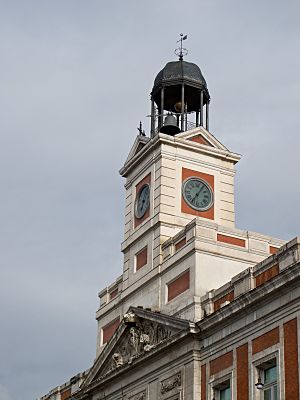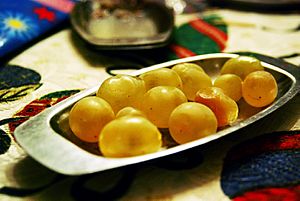Twelve Grapes facts for kids
The Twelve Grapes (called las doce uvas de la suerte in Spanish) is a fun tradition from Spain. It involves eating one grape for each of the twelve clock chimes at midnight on December 31st. This happens right as the New Year begins! Each grape stands for one month of the new year. People believe eating them brings good luck and success for the next twelve months.
This tradition started a long time ago, around 1895. It became very popular in 1909. That year, grape farmers in Alicante had too many grapes. They came up with this idea to help sell them all. Today, most people follow this custom to celebrate the New Year. It is a joyful way to welcome new beginnings.
Contents
How to Celebrate the Twelve Grapes
People celebrate the Twelve Grapes in two main ways. Many families gather at home after their Nochevieja (New Year's Eve) dinner. They watch the clock strike midnight together.
Puerta del Sol Celebration
The most famous place to celebrate is in the main squares of cities. The biggest celebration happens at the Puerta del Sol in Madrid. This is where the tradition first became popular. The clock tower of the Royal House of the Post Office in Puerta del Sol is very important. Its chimes are broadcast live on TV across Spain. This has been happening since 1962. Millions of people watch and eat their grapes along with the clock.
Where Else is This Tradition Celebrated?
The Twelve Grapes tradition has spread beyond Spain. Many countries in Latin America have adopted it. This is because they share a strong cultural connection with Spain. Also, Hispanic communities in countries like the United States follow this custom. The Philippines also celebrates this tradition. Sometimes, people there use other fruits like oranges or watermelon instead of grapes. This special custom is a big part of the Christmas and New Year celebrations in these regions.
See also
 In Spanish: Doce uvas para niños
In Spanish: Doce uvas para niños



